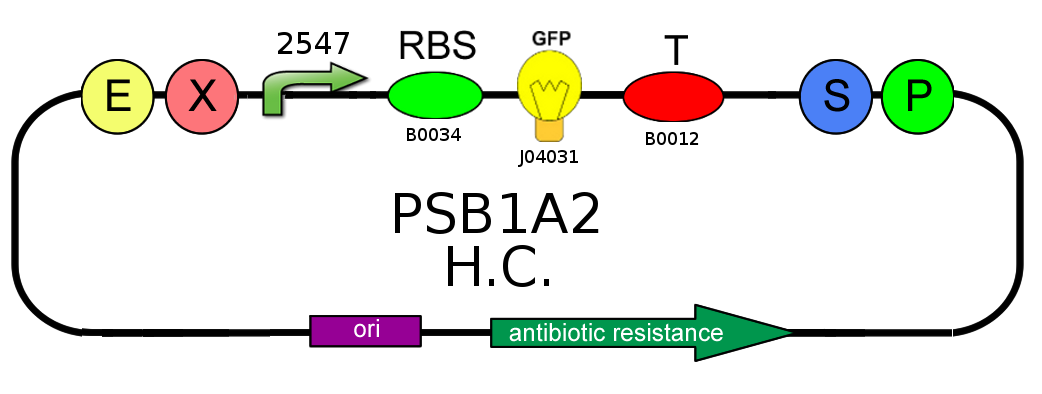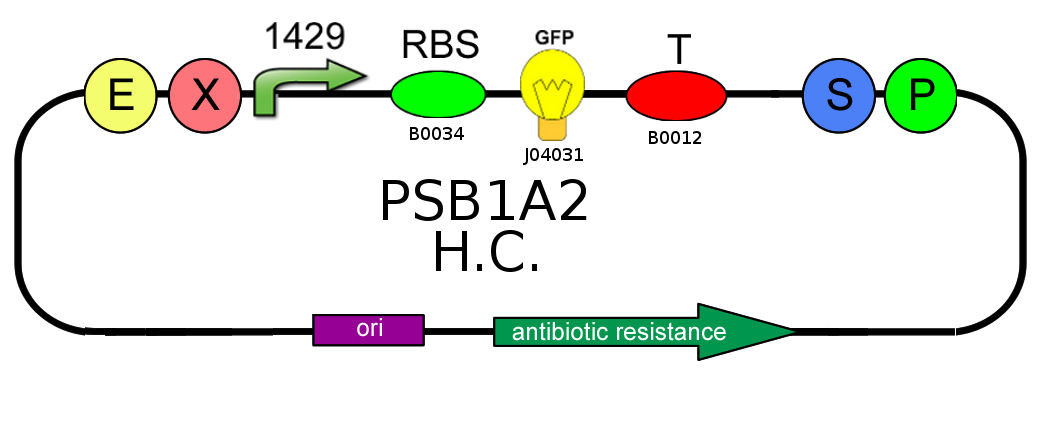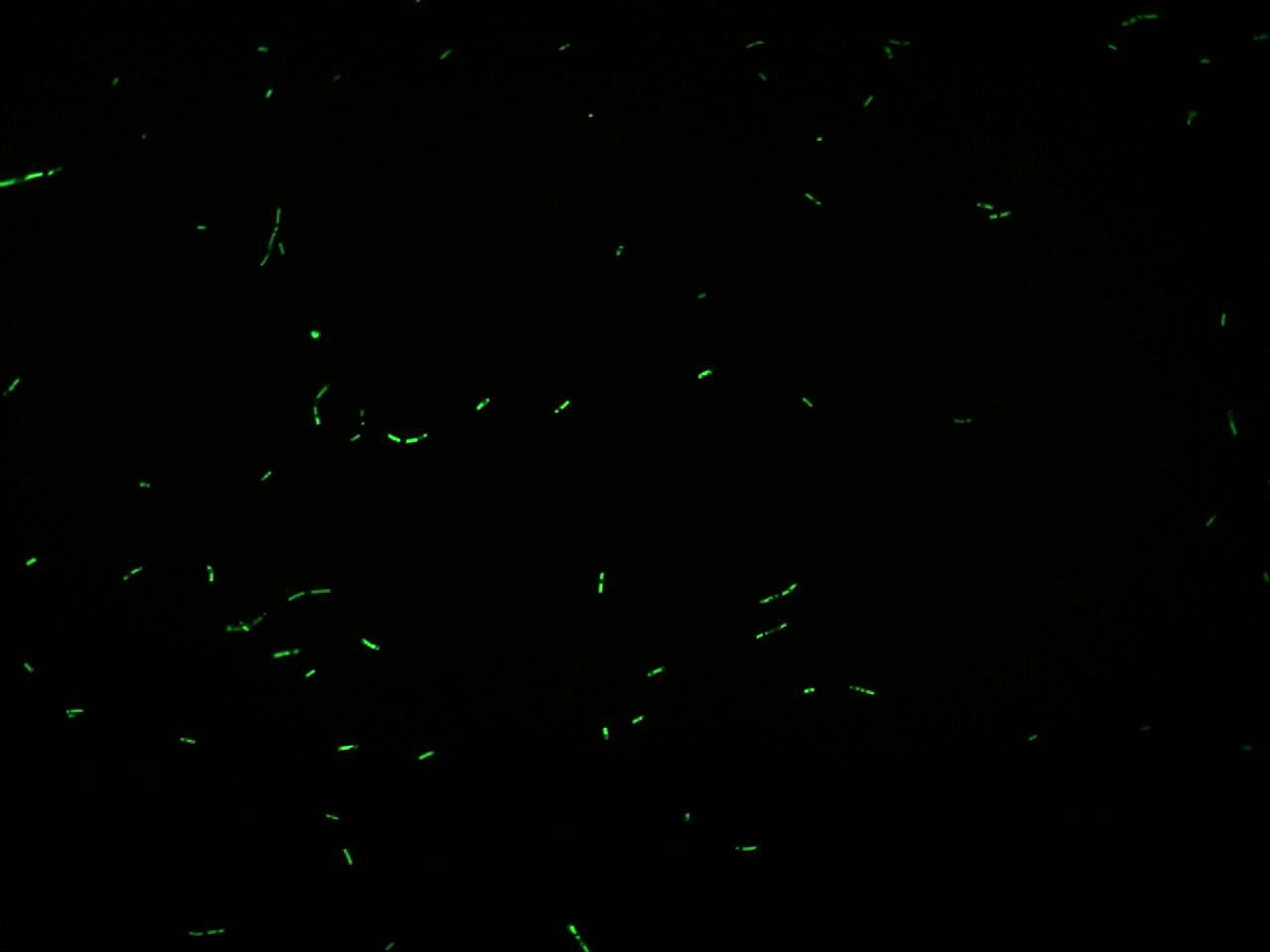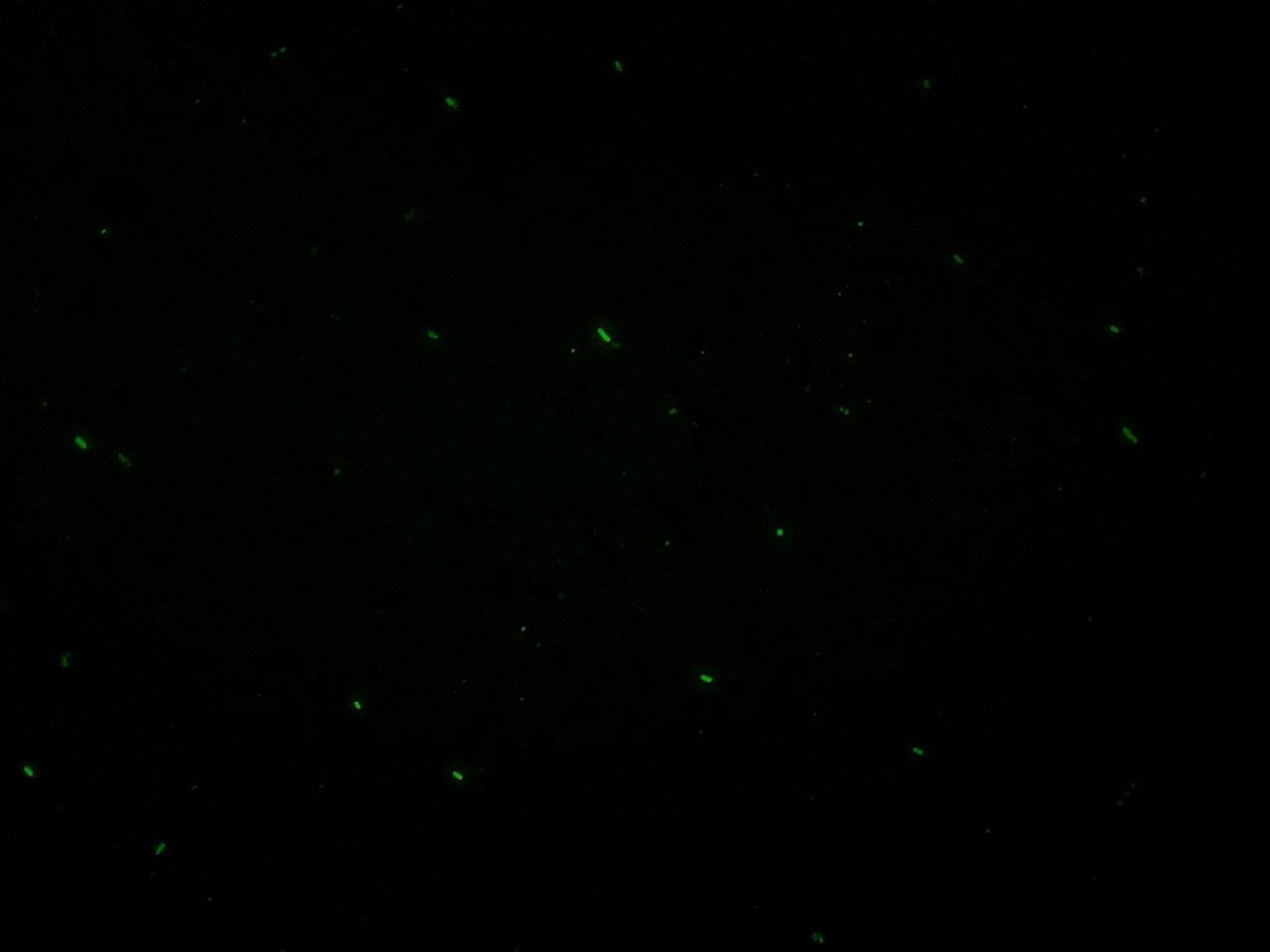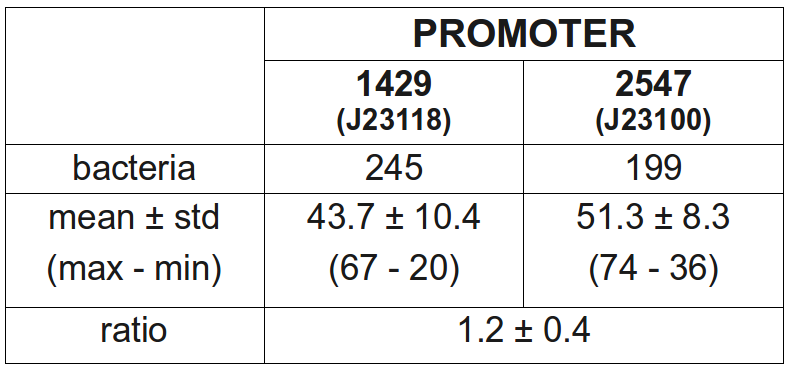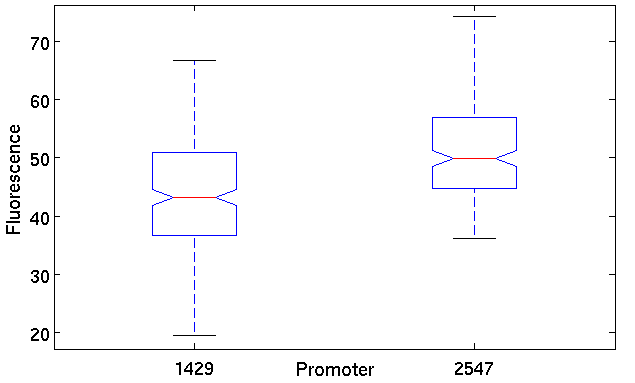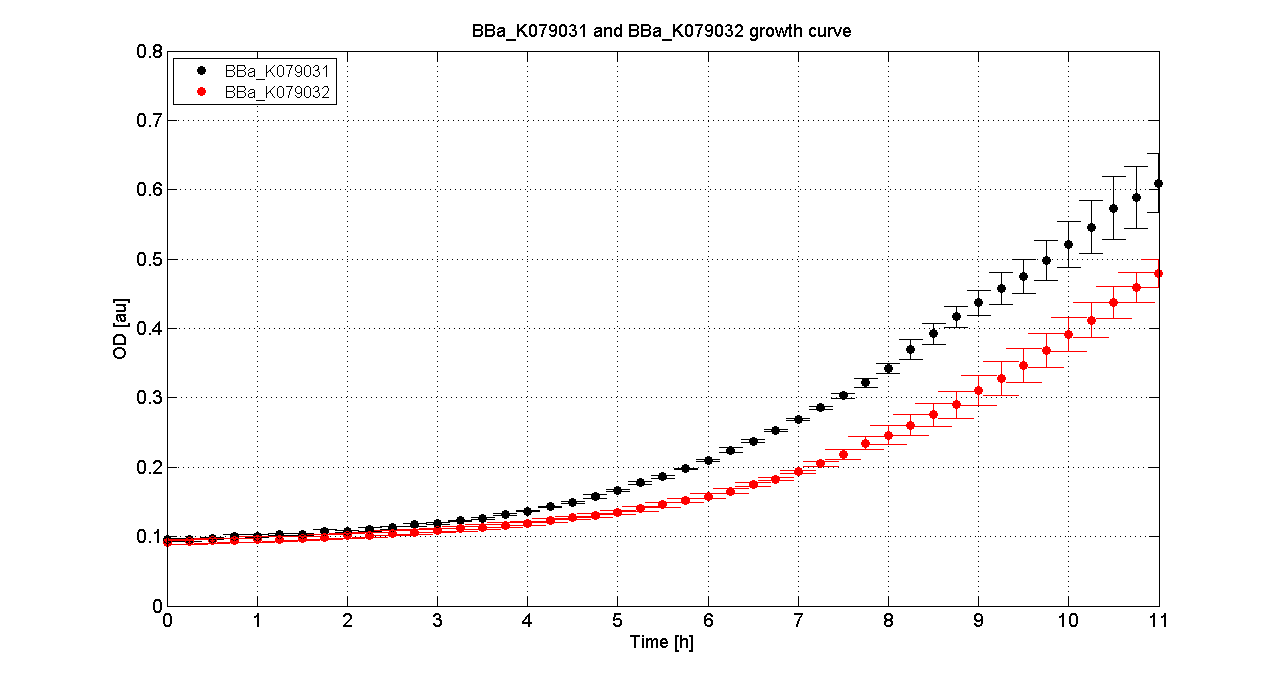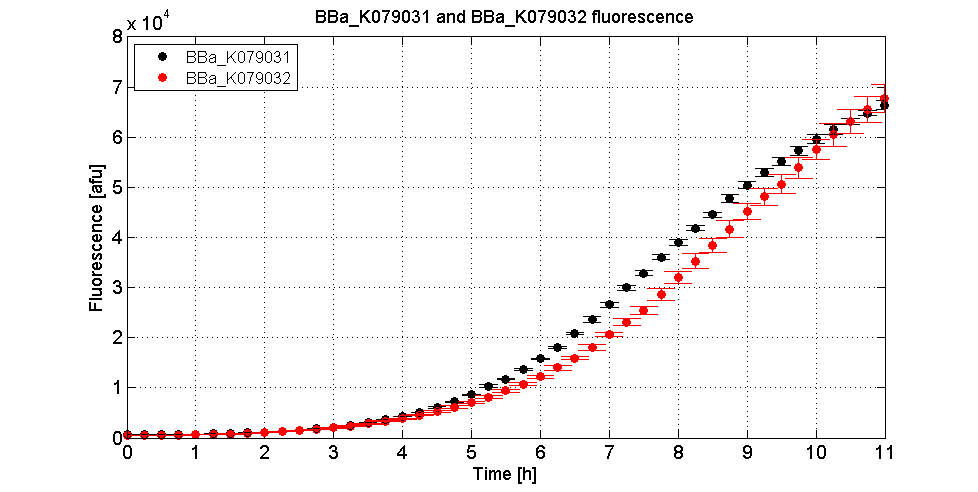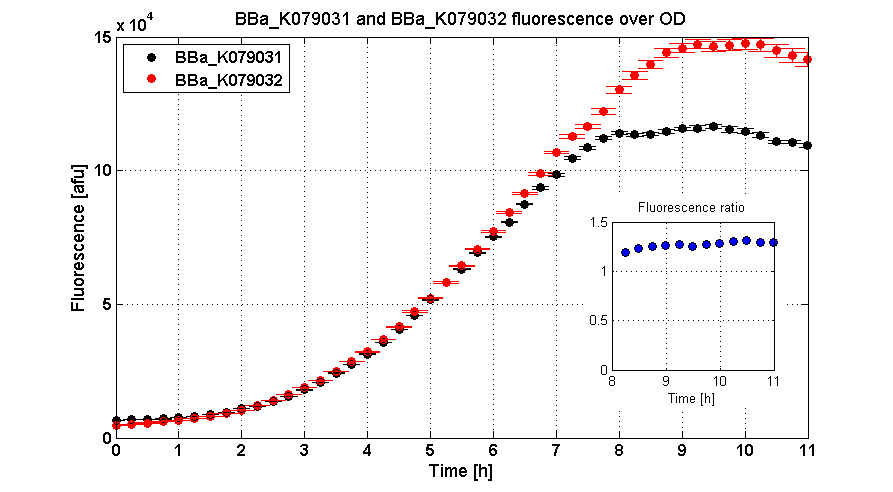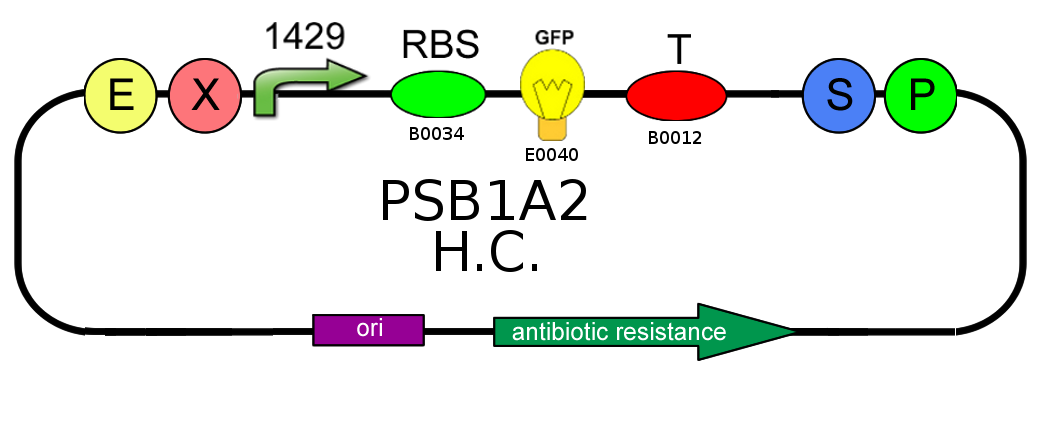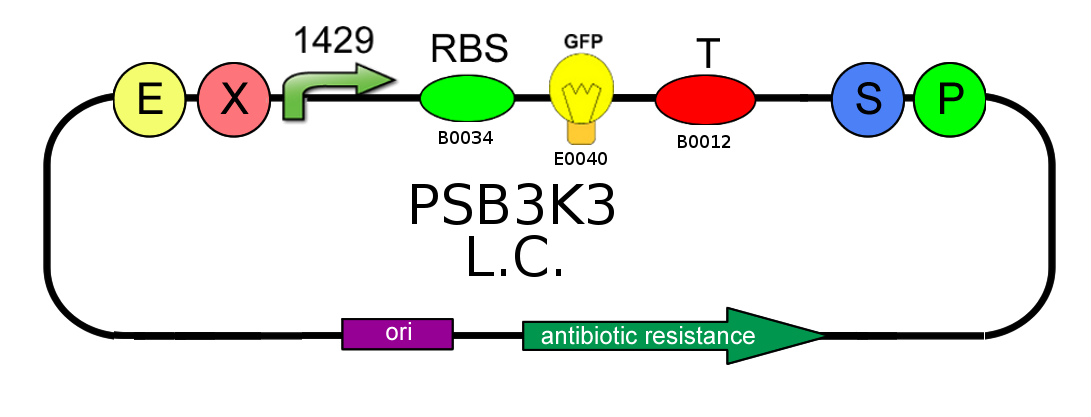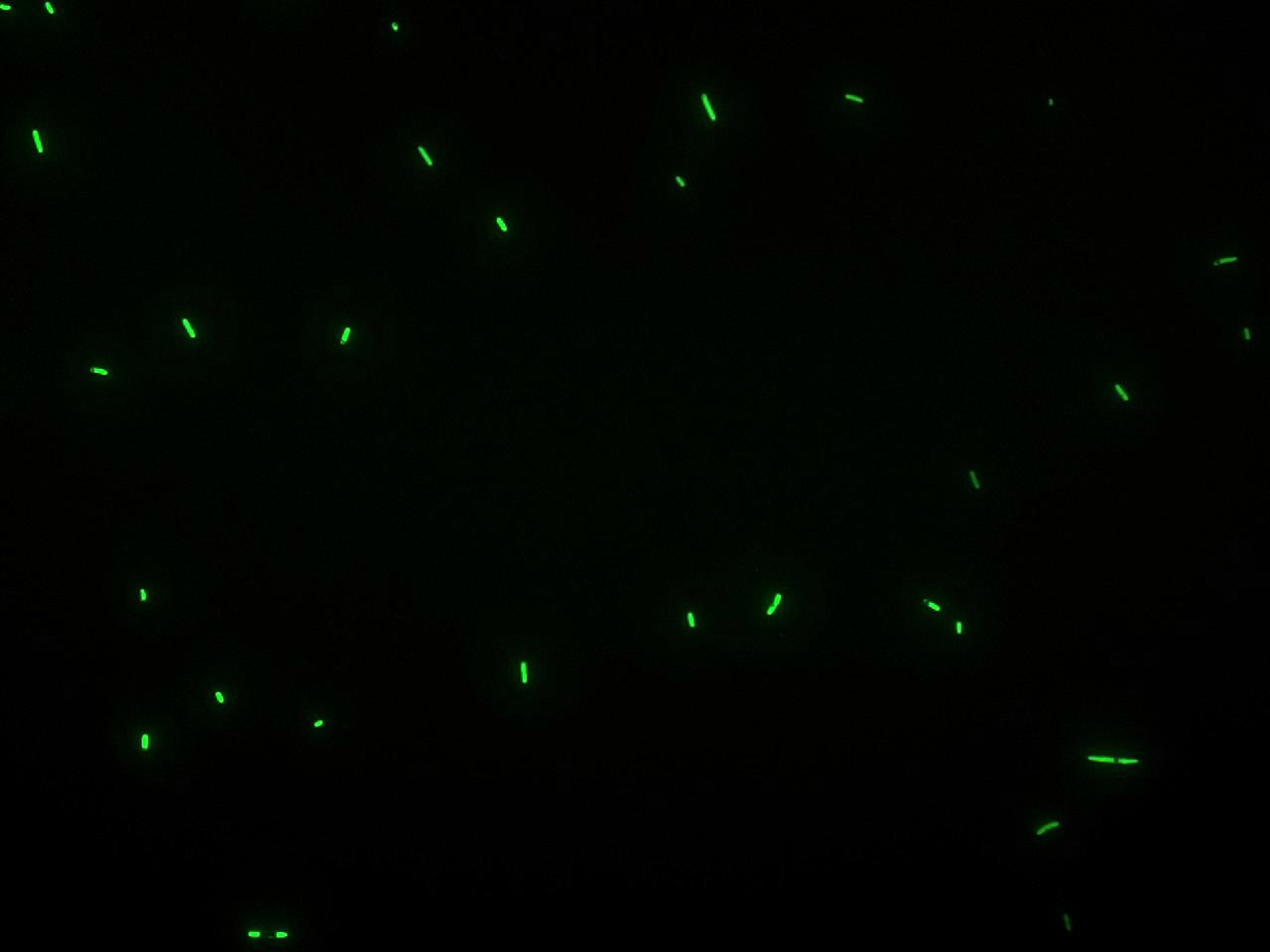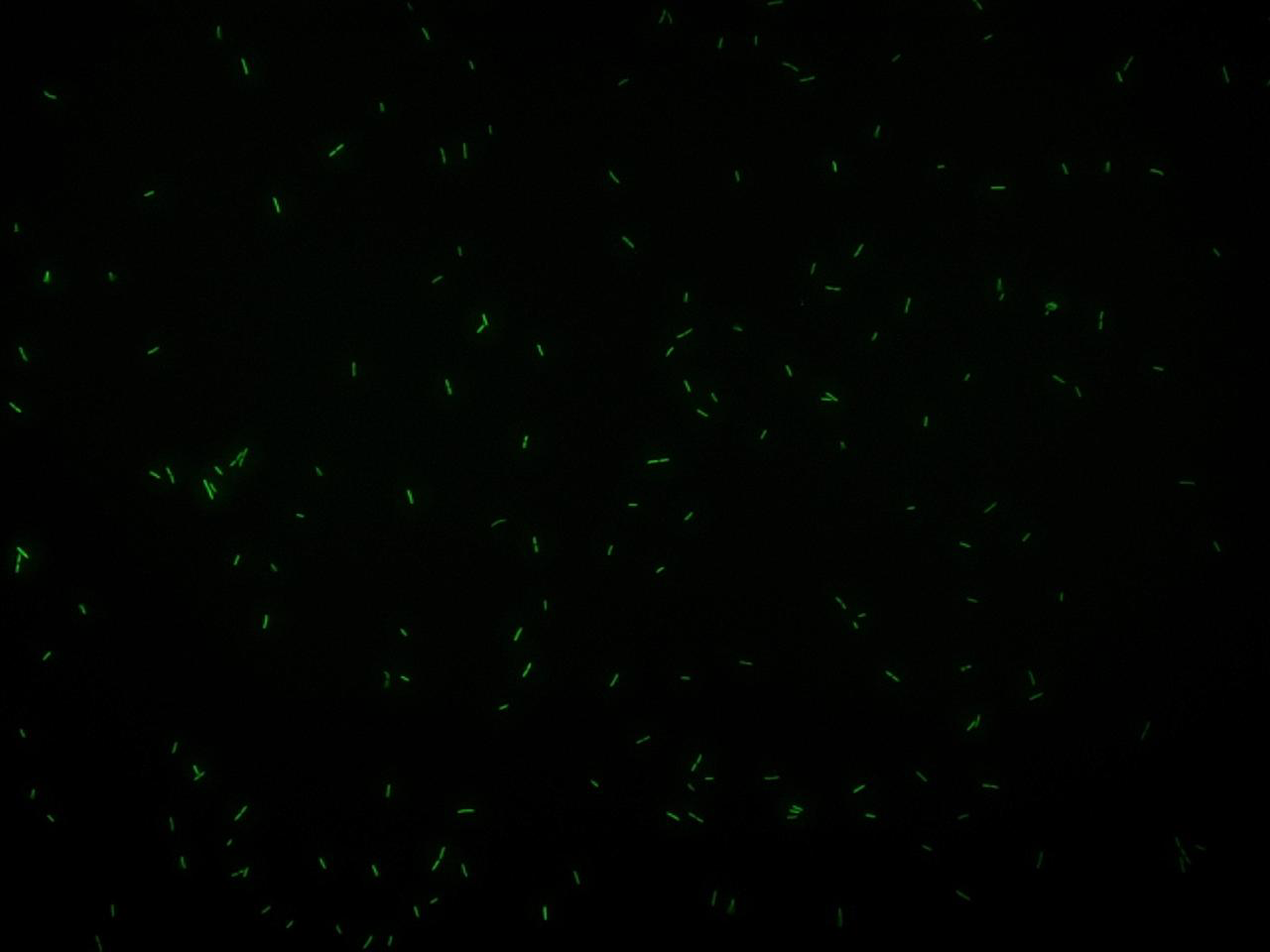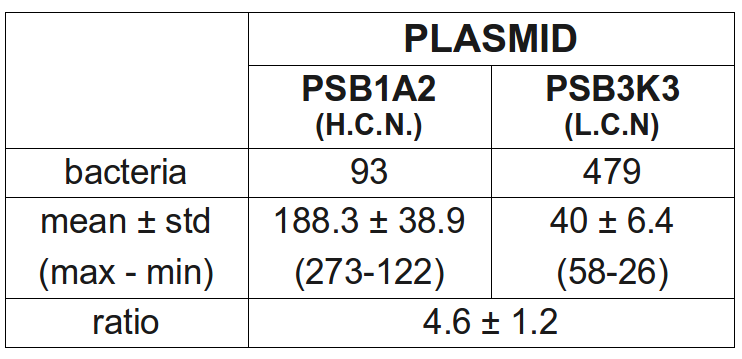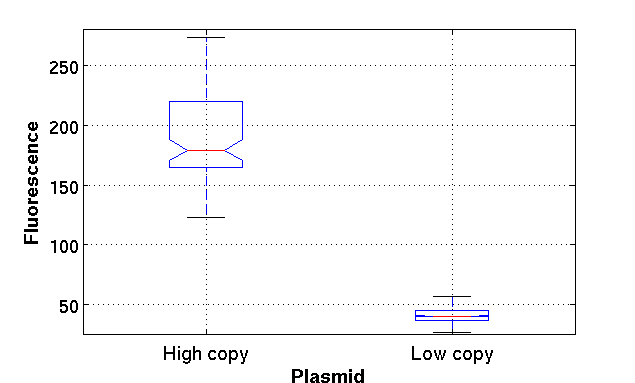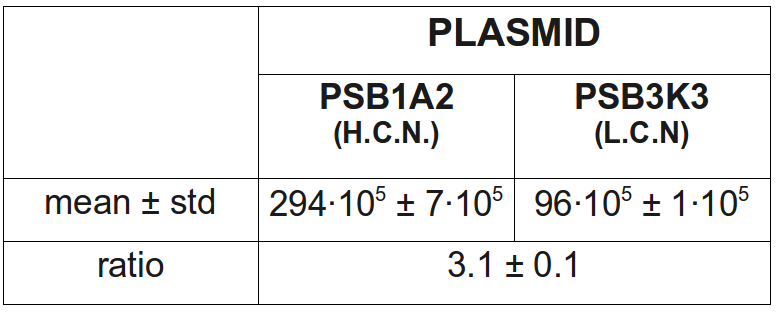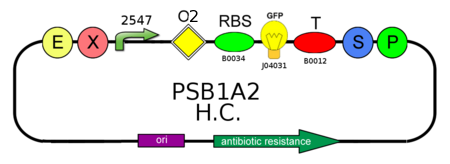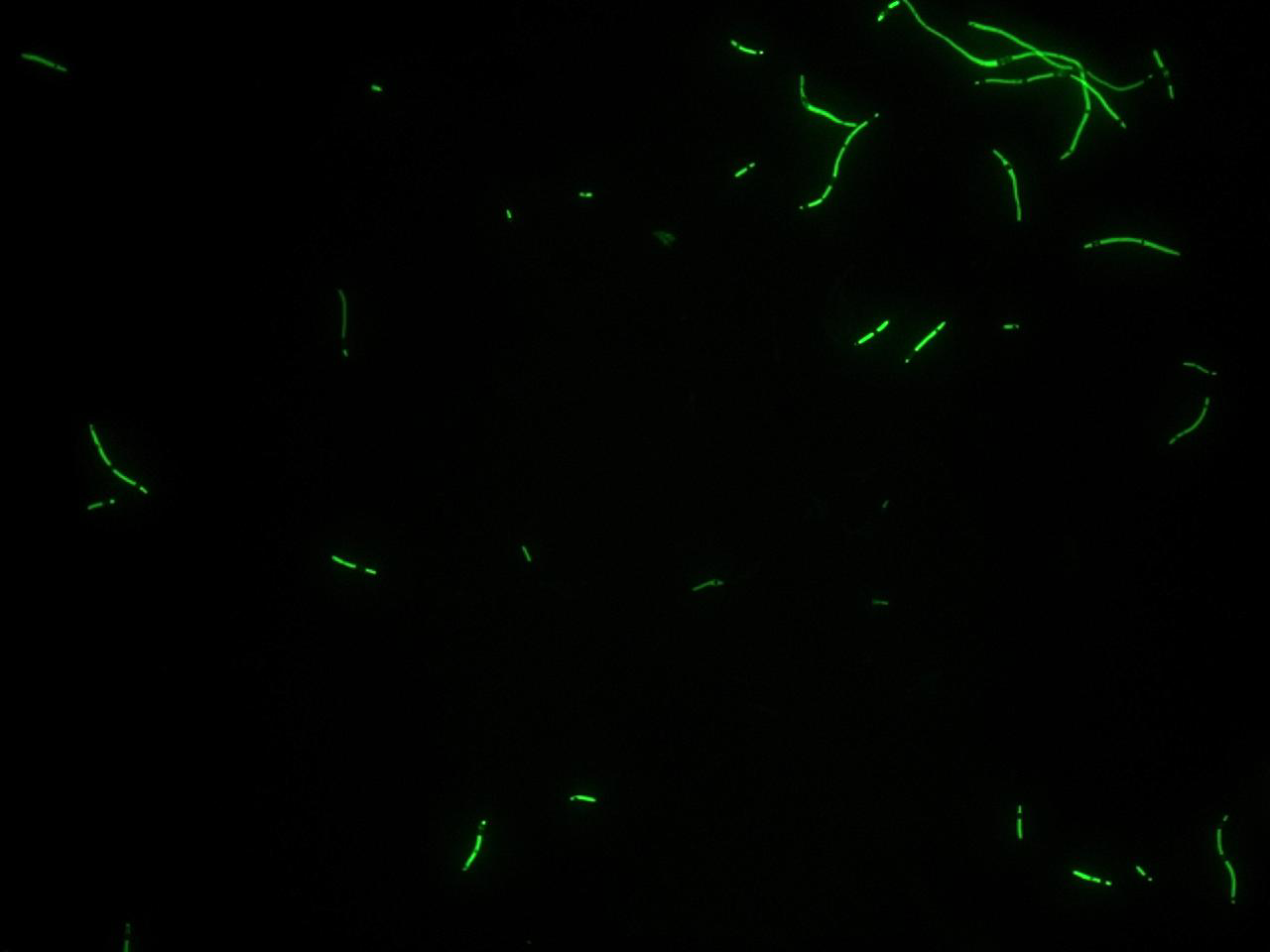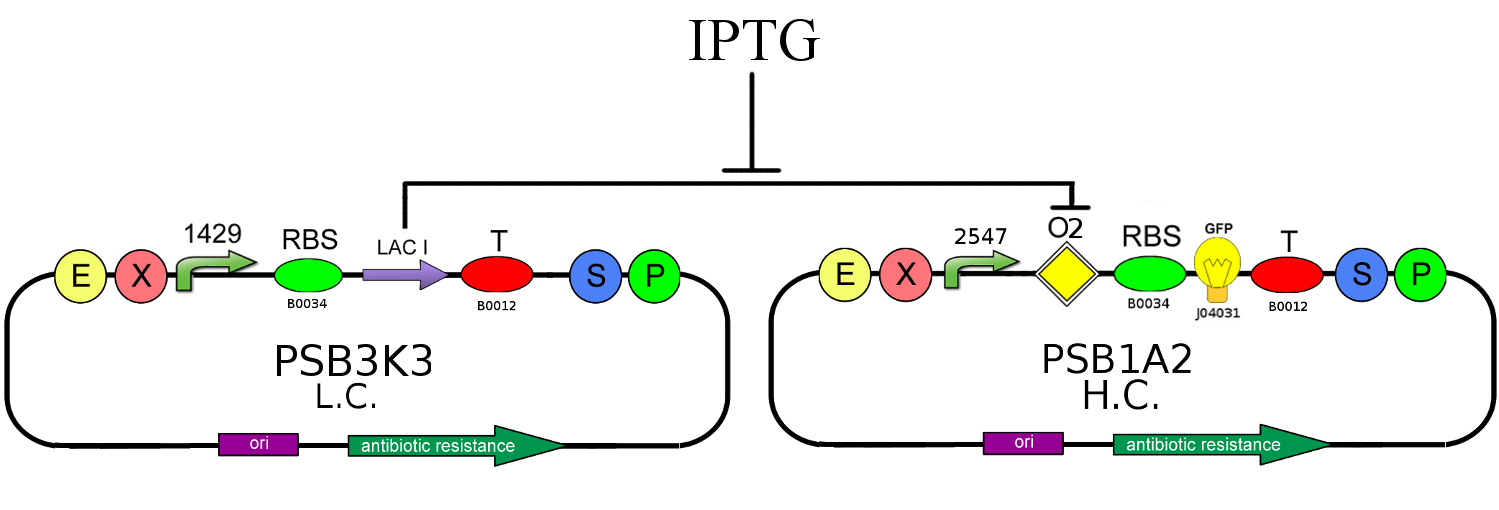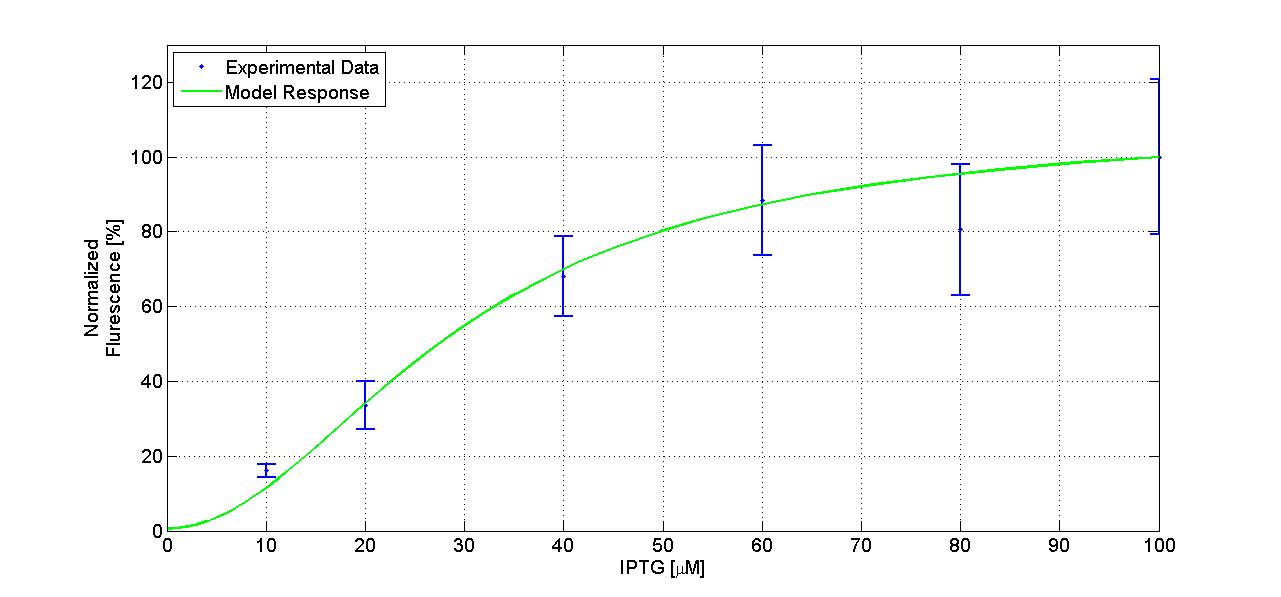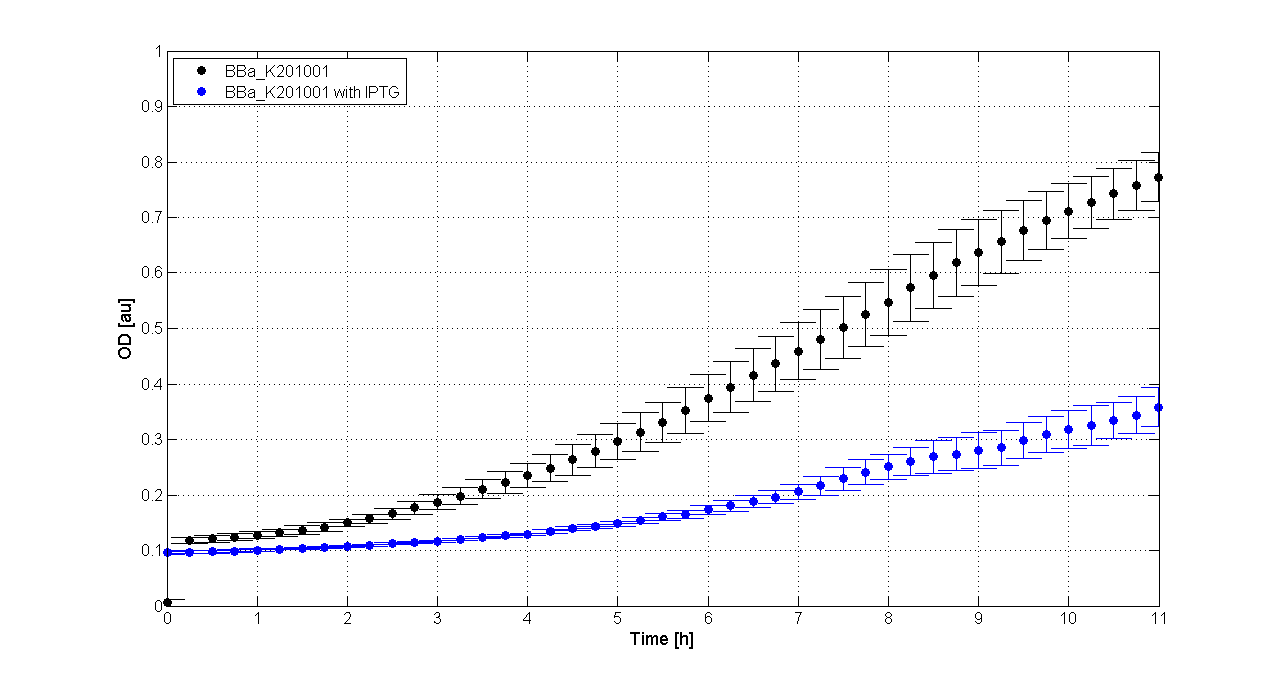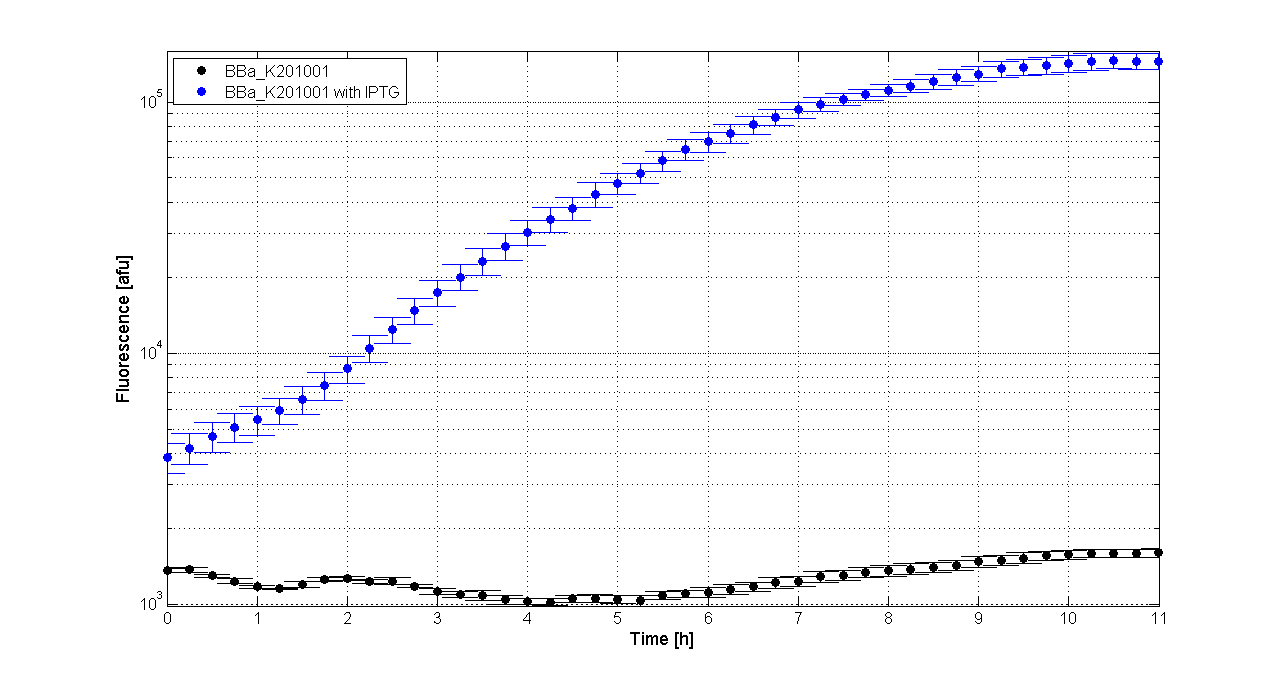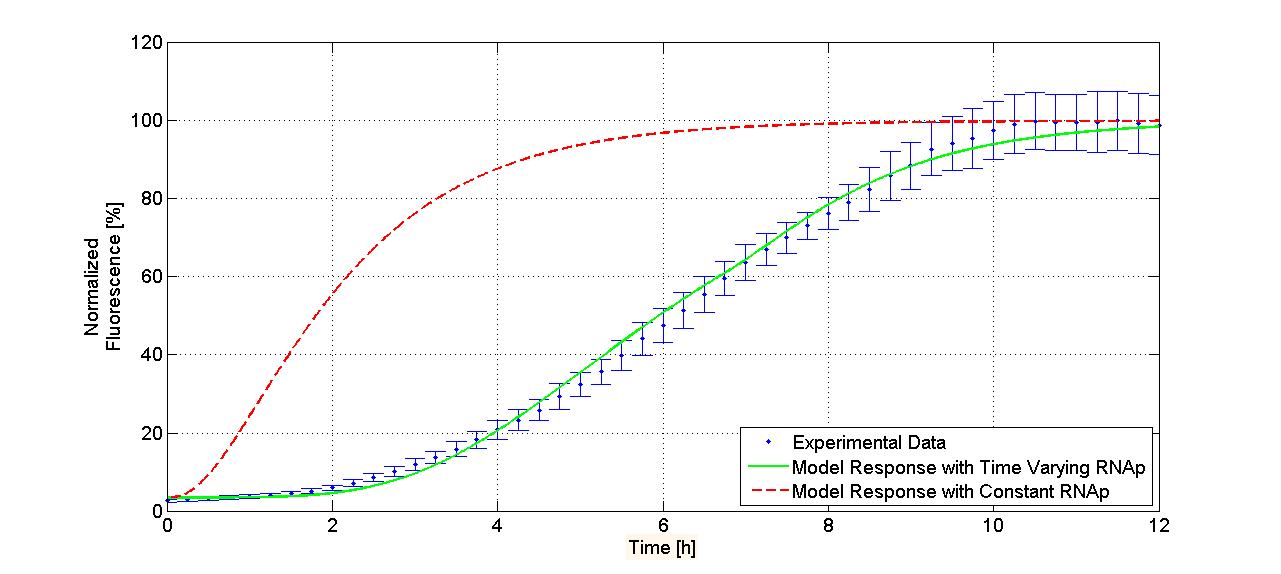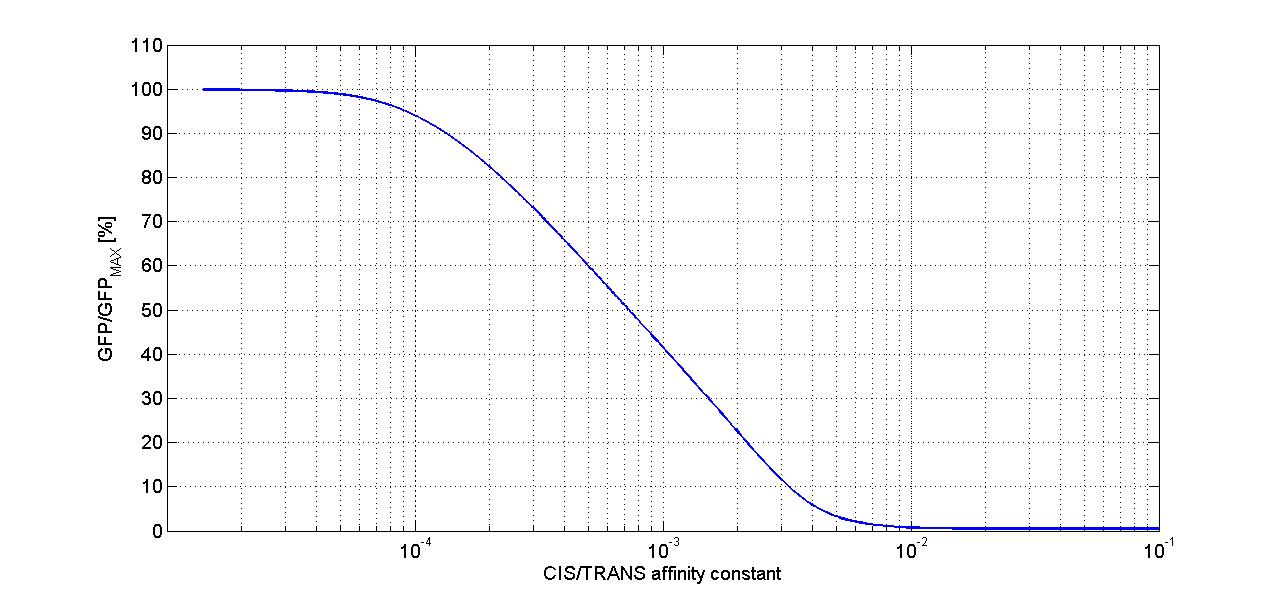Team:Bologna/Characterization
From 2009.igem.org
| (23 intermediate revisions not shown) | |||
| Line 1: | Line 1: | ||
{{Template:BolognaTemplate}} | {{Template:BolognaTemplate}} | ||
| - | |||
| - | |||
<br> | <br> | ||
| - | |||
| - | |||
| - | |||
<br> | <br> | ||
| - | + | =<font face="Calibri" font size="5" color="#000000"><b><i>BBa_J23100</i> vs <i>BBa_J23118</i></b>= | |
| - | < | + | <font face="Calibri" font size="4" color="#000000"> |
| - | + | * In order to identify the ratio between BBa_J23100 and BBa_J23118 promoters, we analyzed the BBa_K079031 and BBa_K079032 GFP production on pSB1A2 (Fig. 1). | |
| - | </font> | + | |
<br> | <br> | ||
| - | |||
| - | |||
| - | |||
| - | |||
{|align="center" | {|align="center" | ||
| - | |[[Image: | + | |[[Image:2547GFP_open_tag.png|center|450 px|thumb|<center><font size="4">Figure 1a - BBa_K079032 on pSB1A2</font></center>]] |
| - | |[[Image: | + | |[[Image:1429GFP_openloop_hc_tag.png|center|450 px|thumb|<center><font size="4">Figure 1b - BBa_K079031 on pSB1A2</font></center>]] |
|} | |} | ||
| - | + | Dh5alpha cells transformed with BBa_K079032 and BBa_K079031 were inoculated in M9 medium O/N. The day after, samples of bacterial cells in the stationary phase were collected and slide prepared for image acquisition with the optical microscope. Images were then analyzed with the VIFluoR software to analyse bacterial fluorescence. | |
| - | + | ||
| - | + | ||
| - | + | ||
| - | + | ||
| - | + | ||
| - | + | ||
{|align="center" | {|align="center" | ||
| - | |[[Image: | + | |[[Image:2500gfpy100cgn170esp0,25pomev6.png|center|thumbnail|385 px|<center><font size="4">Figure 2a - BBa_K079032 bacterial cells</font></center>]] |
| - | |[[Image: | + | |[[Image:1429gfpy100cgn170esp0,5.png|center|thumbnail|385 px|<center><font size="4">Figure 2b - BBa_K079031 bacterial cells</font></center>]] |
|} | |} | ||
| - | |||
| - | |||
<br> | <br> | ||
| - | < | + | Mean fluorescence per bacterium was 51.3± 8.3 a.u. for BBa_K079032 and 43.7±10.4 a.u. for BBa_K079031. Fluorescence ratio BBa_K079032/ BBa_K079031 was 1.20±0.4 (Table 1). |
| + | [[Image:TabellaPromotori3.png|center|400px |thumb|<center><font size="4">Table 1 - Promoter fluorescence ratio after microscope analysis</font></center>]] | ||
| + | [[Image:promotori.png|center|thumbnail|600px|<center><font size="4">Figure 3 - Box Plot of Table 1 data</font></center>]] | ||
| + | The same sample were collected for fluorescence analysis with the Tecan M200 fluorimeter (Table 2) and the fluorescence ratio was confirmed: | ||
| + | [[Image:TabellaPromotoriGrafico2.png|center|400px |thumb|<center><font size="4">Table 2 - Promoter fluorescence ratio after fluorimeter analysis</font></center>]] | ||
| - | = | + | Dilutions from the O/N grown cultures were then obtained (OD = 0.1) and cell let to grow a 37 °C in a Tecan spectrofluorimeter. Both optical density (OD; Fig. 4) and fluorescence level (Fig. 5) were analized during 12 h. Fluorescence/OD ratio is shown over time in Fig.6. |
| - | < | + | [[Image:GrowthCurve1.png|center|600px |thumb|<center>Fig.4 - Growth curve</center>]] |
| - | + | [[Image:FluorescenceCurveAbsolute1.png|center|600px |thumb|<center>Fig.5 - Fluorescence</center>]] | |
| + | [[Image:FluorescenceCurveOverOD1.png|center|600px |thumb|<center>Fig.6 - Fluorescence curve over OD</center>]] | ||
| + | <br> | ||
| + | At the equilibrium once again fluorescence/OD BBa_K079032/ BBa_K079031 ratio was about 1.20 (Fig. 6). A relevant experimental result is the roughly 30fold increase in the fluorescence signal from the single bacterial cell occurring during the time course. A possible explanation of this observation could rely on the required activation of the major s subunit of RNA polymerase for transcription of most of the genes expressed in the exponential growth phase (Jishage M, Ishihama A. Proc Natl Acad Sci USA 1998; 95: 4953–8. See reference section). Too low fluorescence per cell at the beginning of the monitoring, possibly too close to the lower threshold of the fluorimeter, may also explain why BBa_K079032/ BBa_K079031 ratio was clearly apparent only after 8 hrs in culture. | ||
| + | <br> | ||
| + | <br> | ||
| + | =<font size="5" color="#000000"><b><i>pSB1A2</i> vs <i>pSB3K3</i></b>= | ||
| + | <font size="4" color="#000000"> | ||
| + | * In order to identify the ratio between the high copy number the low to medium copy number plasmids, we analyzed the BBa_K201003 GFP production both on pSB1A2 and pSB3K3 (Fig. 7): | ||
<br> | <br> | ||
{|align="center" | {|align="center" | ||
| - | |[[Image: | + | |[[Image:1429GFP_openloop_hc.png|center|450 px|thumb|<center><font size="4">Figure 7a - BBa_K201003 on pSB1A2</font></center>]] |
| - | |[[Image: | + | |[[Image:1429GFP_openloop_lc.png|center|450 px|thumb|<center><font size="4">Figure 7b - BBa_K201003 on pSB3K3</font></center>]] |
|} | |} | ||
| - | + | From the Registry of Standard Biological Parts we knew that pSB1A2 is a high copy number plasmid while pSB3K3 is a low copy one, so the theoretical ratio between their copy number should be at least 10, but the highest value that we reached with the spectrofluorimeter was about 3,3.<br> | |
| - | The | + | The BBa_K201003 with a high copy number plasmid and a low copy number were transformed in DH5alfa bacterial cells according to the standard protocol. |
| - | + | <br> | |
| + | One colony from each plate was picked up and let grow overnight in M9 medium at 37°C. One milliliter for each of the two samples was collected by O/N cultures and spinned at 8000 rpm for a minute; another milliliter was used for measuring the optical density and estimate the growth of the sample. The supernatant was harvested and the pellet resuspended. Slides were prepared for the acquisition of images of fluorescent bacteria. | ||
{|align="center" | {|align="center" | ||
| - | |[[Image: | + | |[[Image:1429i13504psb1a2y100cgn170esp1,4_v1.png|center|thumbnail|385 px|<center><font size="4">Figure 8a - BBa_K201003 on pSB1A2 bacterial cells</font></center>]] |
| - | |[[Image: | + | |[[Image:1429i13504psb3k3y100cgn170esp1,4_v1.png|center|thumbnail|385 px|<center><font size="4">Figure 8b - BBa_K201003 on pSB3K3 bacterial cells</font></center>]] |
|} | |} | ||
| - | |||
| - | |||
| - | |||
| - | |||
| - | |||
| - | |||
| - | |||
| - | |||
| - | |||
<br> | <br> | ||
| - | + | [[Image:plasmidi.png|center|thumbnail|400px|<center><font size="4">Table 3 - Fluorescence ratio after microscope analysis</font></center>]] | |
| - | <br><br> | + | [[Image:boxplotplasmidi.png|center|thumbnail|700px|<center><font size="4">Figure 9 - Box Plot of Table 3 data</font></center>]] |
| + | [[Image:plasmidiGrafico2.png|center|thumbnail|400px|<center><font size="4">Table 3 - Fluorescence ratio after microscope analysis</font></center>]] | ||
| + | <br> | ||
| + | =<font face="Calibri" font size="5" color="#000000"><b><i>Presence</i> vs <i>Absence</i> of LacI O2 natural operator</b>= | ||
| + | <font face="Calibri" font size="4" color="#000000"> | ||
| + | * We needed to confirm that LacI natural operator O2 don't influence GFP production when LacI repressor is not present. We compare then the GFP expression level of BBa_K079032 and BBa_K201001 | ||
| + | <br> | ||
{|align="center" | {|align="center" | ||
| - | |[[Image:2547GFP_open_tag.png|center|450 px]] | + | |[[Image:2547GFP_open_tag.png|center|450 px|thumb|<center><font size="4">Figure 10a - BBa_K079032 on pSB1A2</font></center>]] |
| - | |[[Image:2547GFPO2_open_tag.png|center|450 px]] | + | |[[Image:2547GFPO2_open_tag.png|center|450 px|thumb|<center><font size="4">Figure 10b - BBa_K201001 on pSB1A2</font></center>]] |
|} | |} | ||
| - | |||
<br> | <br> | ||
{|align="center" | {|align="center" | ||
| - | |[[Image:2500gfpy100cgn170esp0,25pomev6.png|center|thumbnail|385 px| | + | |[[Image:2500gfpy100cgn170esp0,25pomev6.png|center|thumbnail|385 px|<center><font size="4">Figura 11a - BBa_K079032 bacterial cells</font></center>]] |
| - | |[[Image:2547gfpy100cgn170esp1v3.png|center|thumbnail|385 px| | + | |[[Image:2547gfpy100cgn170esp1v3.png|center|thumbnail|385 px|<center><font size="4">Figura 11b - BBa_K201001 bacterial cells</font></center>]] |
|} | |} | ||
| + | [[Image:table2547.png|center|thumbnail|500 px|<center><font size="4">Table 5 - Fluorescence ratio after microscope analysis</font></center>]] | ||
| + | |||
<br><br> | <br><br> | ||
| + | =<font face="Calibri" font size="5" color="#000000"><b>LacI induction response</b>= | ||
| + | <font face="Calibri" font size="4" color="#000000"> | ||
| + | * To have a positive control of the testing circuit, we characterized another circuit (Fig. 12) that simulates the behaviour of testing circuit when the T-REX device is idle for the absence of TRANS-repressor or in case that TRANS-repressor mRNA is unable to silence LacI translation. | ||
| + | <br> | ||
| + | [[Image:LACi_GFP2_tag_02.png|center|thumbnail|800 px|<center><font size="4">Figura 12 - BBa_K201001 with BBa_K201002</font></center>]] | ||
| + | <br> | ||
| + | Dh5alpha cells were co-transformed with the [http://partsregistry.org/Part:BBa_K201001:Experience BBa_K201001] on a high copy number plasmid (pSB1A2) and BBa_K201002 on a low copy number plasmid (pSB3K3). To characterize this device and its sensitivity to the inducer, we studied both the static and the dynamic response to IPTG induction. | ||
| + | |||
| + | '''Static response''' | ||
| + | Dh5alpha were inoculated in 5 ml of M9 medium with 0, 10, 20, 40, 60, 80, 100 uM IPTG, respectively. After O/N growth at 37° (about 12 h) samples were collected and slides prepared for microscope analysis. Acquired images were analyzed with the [https://2009.igem.org/Team:Bologna/Software VIFluoR software]. To obtain a significant representation of bacterial fluorescence, it was necessary to acquire several images, each one reporting a sufficient number of bacterial cells (n=60). VIFluoR operates image segmentation and then recognises the bacterial cells, yielding the mean fluorescence per bacterium as the output. The experimental data (Fig. 13) were used to identify, by the [https://2009.igem.org/Team:Bologna/Modeling mathematical model], the operator binding affinity for the repressor LacI '''(K= 1.7 nM)'''. | ||
| + | <br> | ||
| + | |||
| + | [[Image:static_induction_figure.jpg|center|600px|thumb|Fig.13 - Experimental data (blue lines) of the static induction after 0, 10, 20, 40, 60, 80, 100 uM IPTG induction. Data were fitted by the model (green line) to identify the operator-repressor binding affinity ('''K= 1.7 nM''')]] | ||
| + | |||
| + | After parameter identification, we computed by the model the static control curve for the LacI repressed GFP generator (LacI inverter) (Fig.14). | ||
| + | |||
| + | |||
| + | [[Image:LacI_GFP.jpg|center|600px|thumb|Fig.14 - Model prediction of promoter repression by Lac I.]] | ||
| + | |||
| + | |||
| + | '''Dynamic response''' | ||
| + | Dh5alpha cells were inoculated in the morning (9 a.m.) in 5 ml of M9 medium with no IPTG. After daily growth (about 8 h) the culture was diluted to an OD=0.1. To perform the induction analysis, the culture was splitted in two. A half was induced with 100 uM IPTG and the other was grown in control medium. 200 ul of each sample were used to fill plate wells (6 wells each). Cells were grown into a fluorimeter (Tecan M200) O/N (about 12h) at 37°. OD and fluorescence were sampled every 15 min (Fig. 15 and 16, respectively). | ||
| + | |||
| + | [[Image:OD1.png|center|600px|thumb|<center><font size="4">Fig.15 - Growth curve for the uninduced (black line) and induced (100 uM IPTG, light blue line)system.</font></center>]] | ||
| + | [[Image:Fluorescenza1.png|center|600px|thumb|<center><font size="4">Fig.16 - Absolute fluorescence curve for the uninduced (black line) and induced (light blue, 100 uM IPTG)system.</font></center>]] | ||
| + | [[Image:induction_figure.jpg|center|600px|thumb|<center><font size="4">Fig. 17 - Model fitting of the experimental data. Experimental data (black lines) were fitted by the model considering a constant (blue line) or a varying (green line) amount of RNA polymerase</font></center>]] | ||
| + | |||
| + | Experimental data of the fluorescence/OD ratio (Fig. 17; blue symbols) were compared to model predictions obtained either considering a constant (purple line) or progressively increasing (green line) amount of RNA polymerase. A good fitting can only be obtained if RNA polymerase available for transcription increases up to 30fold with respect to the initial value. This is consistent with the required activation of the major sigma subunit of RNA polymerase for transcription of most of the genes expressed in the exponential growth phase (Jishage M, Ishihama A. Proc Natl Acad Sci USA 1998; 95: 4953–8). | ||
| + | |||
| + | =<font face="Calibri" font size="5" color="#000000"><b>Model Prediction of Testing Circuit</b>= | ||
| + | <font face="Calibri" font size="4" color="#000000"> | ||
| + | * To test T-REX device, we developed the genetic circuit (Fig. 18) | ||
| + | [[Image:Circuit2OK.jpg|center|800px|thumb|<center><font size="4">Fig.18 - Testing Circuit</font></center>]] | ||
| + | <br> | ||
| + | After identification of model parametres, the GFP levels as a function of TRANS/CIS affinity was predicted by simulating the whole test circuit (Fig. 19) | ||
| + | [[Image:cistrans.jpg|center|600px|thumb|<center><font size="4">Fig.19 - Model prediction of testing circuit GFP level</font></center>]] | ||
Latest revision as of 03:49, 22 October 2009
| HOME | TEAM | PROJECT | SOFTWARE | MODELING | WET LAB | PARTS | HUMAN PRACTICE | JUDGING CRITERIA |
|---|
Contents |
BBa_J23100 vs BBa_J23118
- In order to identify the ratio between BBa_J23100 and BBa_J23118 promoters, we analyzed the BBa_K079031 and BBa_K079032 GFP production on pSB1A2 (Fig. 1).
Dh5alpha cells transformed with BBa_K079032 and BBa_K079031 were inoculated in M9 medium O/N. The day after, samples of bacterial cells in the stationary phase were collected and slide prepared for image acquisition with the optical microscope. Images were then analyzed with the VIFluoR software to analyse bacterial fluorescence.
Mean fluorescence per bacterium was 51.3± 8.3 a.u. for BBa_K079032 and 43.7±10.4 a.u. for BBa_K079031. Fluorescence ratio BBa_K079032/ BBa_K079031 was 1.20±0.4 (Table 1).
The same sample were collected for fluorescence analysis with the Tecan M200 fluorimeter (Table 2) and the fluorescence ratio was confirmed:
Dilutions from the O/N grown cultures were then obtained (OD = 0.1) and cell let to grow a 37 °C in a Tecan spectrofluorimeter. Both optical density (OD; Fig. 4) and fluorescence level (Fig. 5) were analized during 12 h. Fluorescence/OD ratio is shown over time in Fig.6.
At the equilibrium once again fluorescence/OD BBa_K079032/ BBa_K079031 ratio was about 1.20 (Fig. 6). A relevant experimental result is the roughly 30fold increase in the fluorescence signal from the single bacterial cell occurring during the time course. A possible explanation of this observation could rely on the required activation of the major s subunit of RNA polymerase for transcription of most of the genes expressed in the exponential growth phase (Jishage M, Ishihama A. Proc Natl Acad Sci USA 1998; 95: 4953–8. See reference section). Too low fluorescence per cell at the beginning of the monitoring, possibly too close to the lower threshold of the fluorimeter, may also explain why BBa_K079032/ BBa_K079031 ratio was clearly apparent only after 8 hrs in culture.
pSB1A2 vs pSB3K3
- In order to identify the ratio between the high copy number the low to medium copy number plasmids, we analyzed the BBa_K201003 GFP production both on pSB1A2 and pSB3K3 (Fig. 7):
From the Registry of Standard Biological Parts we knew that pSB1A2 is a high copy number plasmid while pSB3K3 is a low copy one, so the theoretical ratio between their copy number should be at least 10, but the highest value that we reached with the spectrofluorimeter was about 3,3.
The BBa_K201003 with a high copy number plasmid and a low copy number were transformed in DH5alfa bacterial cells according to the standard protocol.
One colony from each plate was picked up and let grow overnight in M9 medium at 37°C. One milliliter for each of the two samples was collected by O/N cultures and spinned at 8000 rpm for a minute; another milliliter was used for measuring the optical density and estimate the growth of the sample. The supernatant was harvested and the pellet resuspended. Slides were prepared for the acquisition of images of fluorescent bacteria.
Presence vs Absence of LacI O2 natural operator
- We needed to confirm that LacI natural operator O2 don't influence GFP production when LacI repressor is not present. We compare then the GFP expression level of BBa_K079032 and BBa_K201001
LacI induction response
- To have a positive control of the testing circuit, we characterized another circuit (Fig. 12) that simulates the behaviour of testing circuit when the T-REX device is idle for the absence of TRANS-repressor or in case that TRANS-repressor mRNA is unable to silence LacI translation.
Dh5alpha cells were co-transformed with the [http://partsregistry.org/Part:BBa_K201001:Experience BBa_K201001] on a high copy number plasmid (pSB1A2) and BBa_K201002 on a low copy number plasmid (pSB3K3). To characterize this device and its sensitivity to the inducer, we studied both the static and the dynamic response to IPTG induction.
Static response
Dh5alpha were inoculated in 5 ml of M9 medium with 0, 10, 20, 40, 60, 80, 100 uM IPTG, respectively. After O/N growth at 37° (about 12 h) samples were collected and slides prepared for microscope analysis. Acquired images were analyzed with the VIFluoR software. To obtain a significant representation of bacterial fluorescence, it was necessary to acquire several images, each one reporting a sufficient number of bacterial cells (n=60). VIFluoR operates image segmentation and then recognises the bacterial cells, yielding the mean fluorescence per bacterium as the output. The experimental data (Fig. 13) were used to identify, by the mathematical model, the operator binding affinity for the repressor LacI (K= 1.7 nM).
After parameter identification, we computed by the model the static control curve for the LacI repressed GFP generator (LacI inverter) (Fig.14).
Dynamic response
Dh5alpha cells were inoculated in the morning (9 a.m.) in 5 ml of M9 medium with no IPTG. After daily growth (about 8 h) the culture was diluted to an OD=0.1. To perform the induction analysis, the culture was splitted in two. A half was induced with 100 uM IPTG and the other was grown in control medium. 200 ul of each sample were used to fill plate wells (6 wells each). Cells were grown into a fluorimeter (Tecan M200) O/N (about 12h) at 37°. OD and fluorescence were sampled every 15 min (Fig. 15 and 16, respectively).
Experimental data of the fluorescence/OD ratio (Fig. 17; blue symbols) were compared to model predictions obtained either considering a constant (purple line) or progressively increasing (green line) amount of RNA polymerase. A good fitting can only be obtained if RNA polymerase available for transcription increases up to 30fold with respect to the initial value. This is consistent with the required activation of the major sigma subunit of RNA polymerase for transcription of most of the genes expressed in the exponential growth phase (Jishage M, Ishihama A. Proc Natl Acad Sci USA 1998; 95: 4953–8).
Model Prediction of Testing Circuit
- To test T-REX device, we developed the genetic circuit (Fig. 18)
After identification of model parametres, the GFP levels as a function of TRANS/CIS affinity was predicted by simulating the whole test circuit (Fig. 19)
 "
"

